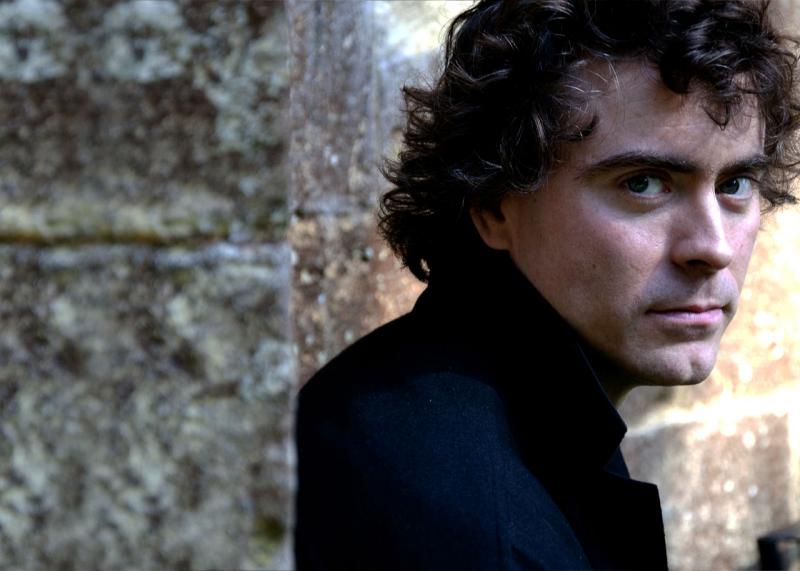Prom 15, Lewis, BBC Philharmonic, Gernon - a masterful Emperor took the musical laurels | reviews, news & interviews
Prom 15, Lewis, BBC Philharmonic, Gernon - a masterful Emperor took the musical laurels
Prom 15, Lewis, BBC Philharmonic, Gernon - a masterful Emperor took the musical laurels
A thoughtful programme on the page didn't quite come into focus in performance

There’s a particular quality to light seen from shadow. Think of the surface of the water glimpsed, hazy and haloed, as you swim upwards after a deep dive, or the smudged edges of city lights seen from a night flight. This concert by Ben Gernon and the BBC Philharmonic was an exercise in adjusted perspective.
Premiered by English National Opera in 2015, Between Worlds is a thoughtful but ultimately unsatisfying operatic treatment of 9/11. Davies’ music, while evocative and sometimes strikingly beautiful, just can't seem to find the narrative urgency or imperative in the events. Perhaps afraid of sensationalising, both she and librettist Nick Drake take so arms-length an approach as to barely be in the same room as their subject matter. So, in theory What Did We See? – a suite newly extracted from the opera by Davies (pictured below) – should finally allow this music to do what it wanted to all along, to mourn and meditate rather than enact.
The sense is of shreds of music torn from a larger musical fabric
To some extent it succeeds. Davies’ ear for texture is canny. Brass players breathe roughly, rhythmically into their mouthpieces – gasps for air, or the sound of a building exhaling in collapse? Either way, it’s horribly evocative, music denatured, reduced to naked sound. And then there is the glinting, metallic stillness that dominates both the first movement “Dark Dream” and the third “Dance of Air and Wire, for Earth” – stillness flickering distantly with movement in the high strings and woodwind.
And yet the suite is an odd creature. The movements don’t finish so much as simply stop, leaving ragged musical threads dangling. The sense is of shreds of music torn from a larger musical fabric – beautiful scraps, but scraps nonetheless. Fragments shored against our ruin? Perhaps, but ones so finely shredded as to be almost impossible to reassemble into any kind of meaningful whole.
 Programmed by Ben Gernon, the BBC Philharmonic’s new Principal Guest Conductor, the concert was a calling card for the young conductor, and the Brahms was a chance to show his mettle. Perhaps the most patrician, certainly the smoothest on the ear of all the BBC Orchestras, the Philharmonic’s strings and principal wind offered the softest and most pastel-smudged of blends. Here was all the lightness and grace of Brahms’ summer vision; delicately phrased arpeggios in the violins, fluttering pizzicatos from the cellos. Playing a long game, Gernon held his forces right back until the final movement, releasing them at last into ebullient movement.
Programmed by Ben Gernon, the BBC Philharmonic’s new Principal Guest Conductor, the concert was a calling card for the young conductor, and the Brahms was a chance to show his mettle. Perhaps the most patrician, certainly the smoothest on the ear of all the BBC Orchestras, the Philharmonic’s strings and principal wind offered the softest and most pastel-smudged of blends. Here was all the lightness and grace of Brahms’ summer vision; delicately phrased arpeggios in the violins, fluttering pizzicatos from the cellos. Playing a long game, Gernon held his forces right back until the final movement, releasing them at last into ebullient movement.
But something about the joy felt inevitable. Where were the shadows of the “black wings” Brahms so vividly described that curdle his first movement lullaby into a minor key? Any clouds over this lovely musical landscape felt fleeting, insubstantial – passing interludes in a day whose sunny ending is already a foregone conclusion. The orchestra played beautifully for Gernon, but there was a tidiness, a politeness here that dulled risk and quietened necessary doubts.
Invading this polite environment like a tiger at the tea table, soloist Paul Lewis brought all the missing spontaneity and transgressive energy to Beethoven’s Fifth Piano Concerto. Unapologetically big-boned, bending and stretching time, he allowed each phrase to unfold on its own terms, occasionally finding more give-and-take in the tempos than Gernon’s obedient ensemble. No smudge of sentimentality blotted the slow movement, gruff bassoons roughed up any musical edges at risk of becoming too smooth, the efficient pacing a bracing contrast to more spacious surrounding movements.
But it was Lewis’s refusal to deploy his full power and volume that was most striking in the awkward space of the Royal Albert Hall. The concerto’s moments of symphonic drama are balanced by chamber dialogues and ensembles, and it was here that Lewis really made his mark, setting us up for a roar and claw, but giving us instead the gentlest, most coaxing of purrs.
rating
Share this article
The future of Arts Journalism
You can stop theartsdesk.com closing!
We urgently need financing to survive. Our fundraising drive has thus far raised £49,000 but we need to reach £100,000 or we will be forced to close. Please contribute here: https://gofund.me/c3f6033d
And if you can forward this information to anyone who might assist, we’d be grateful.

Subscribe to theartsdesk.com
Thank you for continuing to read our work on theartsdesk.com. For unlimited access to every article in its entirety, including our archive of more than 15,000 pieces, we're asking for £5 per month or £40 per year. We feel it's a very good deal, and hope you do too.
To take a subscription now simply click here.
And if you're looking for that extra gift for a friend or family member, why not treat them to a theartsdesk.com gift subscription?
more Classical music
 Jansen, LSO, Pappano, Barbican review - profound and bracing emotional workouts
Great soloist, conductor and orchestra take Britten and Shostakovich to the edge
Jansen, LSO, Pappano, Barbican review - profound and bracing emotional workouts
Great soloist, conductor and orchestra take Britten and Shostakovich to the edge
 Jakub Hrůša and Friends in Concert, Royal Opera review - fleshcreep in two uneven halves
Bartók kept short, and a sprawling Dvořák choral ballad done as well as it could be
Jakub Hrůša and Friends in Concert, Royal Opera review - fleshcreep in two uneven halves
Bartók kept short, and a sprawling Dvořák choral ballad done as well as it could be
 Hadelich, BBC Philharmonic, Storgårds, Bridgewater Hall, Manchester review - youth, fate and pain
Prokofiev in the hands of a fine violinist has surely never sounded better
Hadelich, BBC Philharmonic, Storgårds, Bridgewater Hall, Manchester review - youth, fate and pain
Prokofiev in the hands of a fine violinist has surely never sounded better
 Monteverdi Choir, ORR, Heras-Casado, St Martin-in-the-Fields review - flames of joy and sorrow
First-rate soloists, choir and orchestra unite in a blazing Mozart Requiem
Monteverdi Choir, ORR, Heras-Casado, St Martin-in-the-Fields review - flames of joy and sorrow
First-rate soloists, choir and orchestra unite in a blazing Mozart Requiem
 Cho, LSO, Pappano, Barbican review - finely-focused stormy weather
Chameleonic Seong-Jin Cho is a match for the fine-tuning of the LSO’s Chief Conductor
Cho, LSO, Pappano, Barbican review - finely-focused stormy weather
Chameleonic Seong-Jin Cho is a match for the fine-tuning of the LSO’s Chief Conductor
 Classical CDs: Shrouds, silhouettes and superstition
Cello concertos, choral collections and a stunning tribute to a contemporary giant
Classical CDs: Shrouds, silhouettes and superstition
Cello concertos, choral collections and a stunning tribute to a contemporary giant
 Appl, Levickis, Wigmore Hall review - fun to the fore in cabaret and show songs
A relaxed evening of light-hearted fare, with the accordion offering unusual colours
Appl, Levickis, Wigmore Hall review - fun to the fore in cabaret and show songs
A relaxed evening of light-hearted fare, with the accordion offering unusual colours
 Lammermuir Festival 2025, Part 2 review - from the soaringly sublime to the zoologically ridiculous
Bigger than ever, and the quality remains astonishingly high
Lammermuir Festival 2025, Part 2 review - from the soaringly sublime to the zoologically ridiculous
Bigger than ever, and the quality remains astonishingly high
 BBC Proms: Ehnes, Sinfonia of London, Wilson review - aspects of love
Sensuous Ravel, and bittersweet Bernstein, on an amorous evening
BBC Proms: Ehnes, Sinfonia of London, Wilson review - aspects of love
Sensuous Ravel, and bittersweet Bernstein, on an amorous evening
 Presteigne Festival 2025 review - new music is centre stage in the Welsh Marches
Music by 30 living composers, with Eleanor Alberga topping the bill
Presteigne Festival 2025 review - new music is centre stage in the Welsh Marches
Music by 30 living composers, with Eleanor Alberga topping the bill
 Lammermuir Festival 2025 review - music with soul from the heart of East Lothian
Baroque splendour, and chamber-ensemble drama, amid history-haunted lands
Lammermuir Festival 2025 review - music with soul from the heart of East Lothian
Baroque splendour, and chamber-ensemble drama, amid history-haunted lands
 BBC Proms: Steinbacher, RPO, Petrenko / Sternath, BBCSO, Oramo review - double-bill mixed bag
Young pianist shines in Grieg but Bliss’s portentous cantata disappoints
BBC Proms: Steinbacher, RPO, Petrenko / Sternath, BBCSO, Oramo review - double-bill mixed bag
Young pianist shines in Grieg but Bliss’s portentous cantata disappoints

Add comment